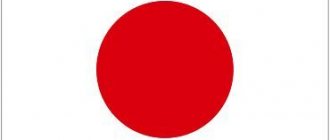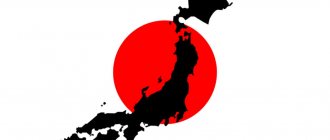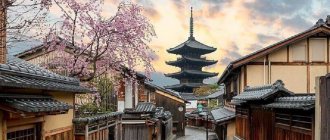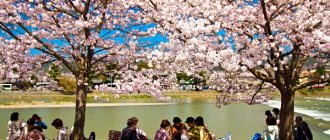There is an opinion among Russians that prices in Japan are very high and living in this country is very expensive. Indeed, a tourist, unlike a local resident, spends a lot of money on paying for hotel accommodation, food, travel on public transport, exciting excursions and, of course, shopping. Costs can be reduced with proper planning, but large expenses will still not be avoided. However, the money will not be spent in vain, since the goods purchased for it and the services received will be only of the highest quality.
How much money should you take with you to Japan?
For those who want to visit the Land of the Rising Sun, the question of how much it costs to travel to Japan becomes relevant. The final amount of expenses depends on the number of days planned for vacation. But one of the significant cost items is the cost of the flight. For example, from Moscow airports, average ticket prices fluctuate around 27,000 rubles.
There is a visa regime between the Russian Federation and the island state. Obtaining a visa stamp in a foreign passport will cost a Russian citizen:
- 15–17 dollars if you apply for a visa yourself. There is no consular fee - only the shipping of documents is paid;
- 50–100 dollars if you use the services of intermediaries.
Staying in Japan also involves expenses. They are described in more detail below, but now let’s say that, as practice shows, a trip for two will cost:
- 110–115 thousand rubles if the tour lasts a week;
- 128–130 thousand rubles – for a 10-day trip.
To reduce costs, it is recommended to exchange Russian rubles for Japanese yen in the Russian Federation. You can import up to 1 million yen without a declaration.
Banks of Japan
Japanese banks are open 09:00-15:00. Local banks are closed on Saturdays, Sundays and holidays. Currency exchange in banks usually closes together.
The Central Bank of Japan regulates the banking system in the country. The largest banks in Japan are: Mitsubishi UFJ Financial Group, Sumitomo Mitsui Financial Group, Mizuho Financial Group, Bank of Nagoya, Bank of Saga Ltd., Bank of Yokohama, Japan Bank for International Cooperation and Nanto Bank.
Level of food expenses
Japan is a country of pathological workaholics. For this reason, local food retailers have a wide selection of ready-made dishes. They just need to be warmed up.
On store shelves you can find food with a thermal button on the packaging. Pressing it starts a chemical reaction, due to which the contents heat up.
Cost of products in stores and supermarkets
The average price for products in Japan in 2021 by retail establishments is shown in the table.
| Product name | Price | |
| U.S. dollars | Yen | |
| Standard ready-made lunch set: noodles, tofu, portion of meat | from 4.7 | from 500 |
| Sea vegetable salad (sea cabbage with corn) | 3.76 | 400 |
| Fresh fish, 1 kg | 9.4–10.34 | 1 000–1 100 |
| Bigeye tuna frozen, 1 kg | 11.65 | 1239 |
| Semi-finished meat products from marbled beef | 5.64–9.4 | 600–1 000 |
| Milk, 1 liter | 1.74 | 185 |
| Loaf of fresh white bread (500g) | 1.81 | 192 |
| Local cheese, 1 kg | 15.05 | 1600 |
| A dozen eggs | 2.13 | 226 |
| Boneless, skinless chicken breasts, 1 kg | 7.32 | 778 |
| Potatoes, 1 kg | 3.79 | 403 |
| Oranges, 1 kg | 5.31 | 565 |
| Apples, 1 kg | 4.18 | 444 |
Given the relative high cost, it may seem surprising that the price level for strong alcoholic drinks and wines in Japan is comparable to that in Russia. To verify this, check out the data in the following table:
| Drink | Price | |
| Yen | Rubles | |
| sake | ||
| bottle 2 l | 2000 | 1255 |
| 0.33 liters | 370–450 | 232–282 |
| South Korean sweet potato soju vodka, 0.7 l | 1000 | 627 |
| Whiskey variety Ballantine`s, Jim Beam | 1 200–1 300 | 753–816 |
| Grape wine, 0.7 l | 700–800 | 439–502 |
| Fruit wine, box 2 l | from 900 | from 565 |
How much does it cost to eat in cafes and restaurants?
Food prices in Japanese catering establishments are quite reasonable by Russian standards. But, despite the fact that the dishes are relatively inexpensive, they all differ in quality.
The cost of some dishes in restaurants is presented below.
| Dish | Price | |
| Yen | Rubles | |
| Rice with mussels and shrimp | 650–700 | 408–439 |
| Pizza: | ||
| with seafood | 1200 | 753 |
| with meat | 1000 | 627 |
| Vegetable salad | 450 | 282 |
| Tom Yum soup with shrimp and salmon | 800–900 | 502–565 |
| Spaghetti in a wok pan | 800 | 502 |
Prices in cafes in Japan, even in its capital, are usually low. You can find a suitable place for lunch in Tokyo not only on the street, but also at the metro station. Below are prices in budget cafes in the metropolis.
| Dish | Price | |
| Yen | Rubles | |
| Lunch set: broth, rice with meat, salad | 750–950 | 467–591 |
| Ramen – wheat noodle soup | 400 | 249 |
| Spaghetti on cast iron | 780 | 485 |
| Rice with seafood | 650 | 404 |
| Thai fried noodles | 680 | 423 |
| Rolls (2 pcs) in the sushi bar | 100 | 62 |
The average bill in an inexpensive Tokyo cafe is approximately 1,200 yen (746 rubles).
Supermarkets in Japan have a very wide selection of baby food. On the packaging of these products, large numbers indicate the age (in months) from which you can feed them to babies. So the young mother will always be able to make the right choice.
Prices for baby food are quite high, for example:
- Meiji Hohoemi Powder Milk formula weighing 800 g costs 9,654 yen (5,986 rubles);
- a regular milk substitute for children suffering from allergies - Wakodo Bonrakutoa - a jar weighing 360 g costs 9,778 yen (6,082 rubles).
On the menu of preschool and school-age children, their parents include burdock root, spinach, boiled white fish and, of course, rice.
Additional information about living standards in Japan is provided by the article “About life in Japan: conditions, cost, mentality.”
Food, drinks in cafes/restaurants
In addition to the weekly grocery list, there are times when Elin may eat out or buy prepared food:
Breakfast - mega coffee and onigiri from Lawson, 450 yen Lunch - combo salad and tea, 500 yen
She also spends about 300 yen a day on snacks such as chocolate, energy bars or fruit. She sometimes visits bars, izakayas and/or restaurants 2 or 3 times a week, and it costs her about 6,000 yen
in Week.
Some costs may also include a serving of ramen for 800 yen and a standard alcoholic drink for 500 yen. If she goes to a cafe for lunch, it will cost about 2000 yen, a sushi lunch can cost from 900 to 2000 yen, coffee - 500 yen.
Housing costs
The answer to what real estate prices are in Japan depends on the location of the property of interest. In the capital, a square meter of housing is the most expensive - about 6,000–8,000 dollars. But Tokyo is not all of Japan. For example, in the city of Fukuoka, a one-room apartment with an area of 20 m2 can be purchased on the secondary market for 1.5 million yen ($14,087).
The article “Real Estate in Japan: search, prices, purchase subtleties” will tell you how to look for real estate, what housing prices are, purchasing costs and other tips that may be useful when buying real estate.
As for rental housing in this city, the numbers are as follows:
- subletting a 1-room apartment from 18 m2 will cost per month ranging from 30 thousand to 40 thousand yen ($282–376);
- for renting a 2-room living space you will have to pay about 50 thousand–70 thousand yen ($470–657) per month;
- the cost of renting a 3-room apartment ranges from 70 thousand to 100 thousand yen ($657–939 dollars).
Utility costs must be added to the rent. On average they are:
| Type of housing and area | Yen | Rubles |
| Small house or apartment up to 85 m2 with 3 bedrooms | 19404 | 12070 |
| Apartment of 50–65 m2 with 2 bedrooms | 15409 | 9585 |
| Apartment with an area of 40–45 m2 with 1 bedroom | 12555 | 7809 |
| Studio with an area of 30 m2 | 9131 | 5680 |
iPhone lives for two years
Internet and communications in the country are quite expensive. Cellular communication most often comes “bundled” with the device itself: every two years, cellular companies give out freshly released iPhones on credit, which the lucky owners pay off within 2 years for about 100 USD per month - right in time for the release of the next new product. So don’t be surprised when you see the latest model iPhones in the hands of literally every first person on a Japanese train.
Of course, there are also budget cellular plans starting from 30 USD, without regular device replacement. But would you be able to walk around with an old iPhone 7, knowing that you have the opportunity to get the 11th model right now and seeing how your friends and colleagues are already flaunting it with might and main?
Transport costs
The most convenient form of transport in Japan is the subway. In addition to Tokyo, it operates in many Japanese cities, for example, Kyoto, Nagoya, Osaka. Let's take the capital's prices as a guide. Depending on the mileage, the cost of a trip on the Tokyo subway ranges from 180–310 yen (112–193 rubles).
Bus routes in large cities are usually connected to metro stations. As a rule, their length is small. The cost of the trip is relatively low and fixed - in the central zone of the Japanese capital it is 120–150 yen (75–93 rubles).
Taxis are especially popular among local citizens and tourists. But it's not cheap. Below are approximate rates:
- landing and initial 2 km - from 600 yen (373 rubles);
- every subsequent 0.5 km – 100 yen (62 rubles);
- parking and driving in traffic jams – 100 yen for 2 minutes;
- when the car is waiting for a client - 100 yen for 2 minutes.
Those tourists who plan to rent a car in Japan need to know how much gasoline costs at gas stations in the country. The numbers are:
- analogue AI-98 – 150.4 yen (94 rubles);
- analogue AI-92 – 139.4 yen (87 rubles);
- diesel fuel - 120.4 (75 rubles).
The article “Features of Japanese transport” will tell you more about the transport system of Japan.
Matchmaking
60% of single Japanese working women are poor.
On the other hand, some rural areas of Japan have implemented an interesting "matchmaker reward" system. Nowadays, most young people do not want to live in rural areas or away from the metropolis. Upon reaching the age of independence, many young people choose to leave their hometowns for cities, which directly leads to an unbalanced population distribution in Japan and a decline in regional rural industries. In rural areas with dwindling populations, it is difficult for men and women wishing to marry to find each other, so in some cities the compensation for matchmakers ranges from 50,000 to 200,000 yen.
Take for example the village of Kosuge in Yamanashi Prefecture near Okutama in Tokyo. It is located at the source of the Tama River and is surrounded by mountains. In this mountain village at an altitude similar to the Tokyo Skytree, matchmakers who successfully match a young villager with a marriage partner are eligible to receive a 200,000 yen reward from the government, provided the couple intends to stay in the village forever. In other words, getting this award may not be as easy as you think!
Japan village dies as young women flee to Tokyo
Views: 833
Share link:
- Tweet
- Share posts on Tumblr
- Telegram
- More
- by email
- Seal
Liked this:
Like
Education expenses
The education system in Japan consists of 4 levels. Preschool institutions are divided into kindergartens and centers specializing in child care.
Such enterprises cannot be called cheap. Parents pay approximately 2.5 million yen (RUB 1,555,032) per year for their child’s stay in kindergarten.
Japanese children enter primary school at the age of 6. The cost of classes in private educational institutions is approaching 400 thousand yen (248,805 rubles) per year.
Secondary education includes 2 levels:
- Partial education is free for children who live in the Land of the Rising Sun permanently.
- Full costs: in a public school - 230 thousand yen (143,063 rubles) per year, in a private school - 960 thousand yen (597,132 rubles) per year.
- Obtaining higher education at a public university will cost approximately 2.42 million yen (1,505,271 rubles), and at a private university - from 3.85 to 5.18 million yen (2,394,750–3,222,027 rubles).
The article “How to get an education in Japan: stages, features, cost” will answer questions regarding the system, cost and timing of training.
Results
A comparative table of the pros and cons of migration in this direction will help you determine whether it is worth moving to Japan:
| Advantages | Flaws |
| high level of economic and technological development of the state; | frequent earthquakes, tsunamis, high probability of volcanic eruptions; |
| low crime rate; | a rather harsh climate in the northern regions, high humidity in the southern regions; |
| well developed medicine; | the complex legalization process due to Japan’s closedness to migrants; |
| additional employment opportunities if you speak English, Japanese and some third language; | difference in mentality; |
| the variety of climatic zones allows you to choose a suitable region for living; | Difficult language; |
| prospects for obtaining a good position for highly qualified specialists; | almost complete lack of opportunities to find unskilled part-time work; |
| Possibility of visa-free entry into most countries | high prices; |
| Even after living in the country for a long time, it is very difficult for the Japanese to become “one of our own” |
Cost of Japanese medicine
Treatment costs do not have such a significant impact on the cost of living in Japan compared to what is observed in Western Europe and the United States. The table shows approximate figures.
| Type of service | Price | ||
| dollars | yen | rubles | |
| Heart valve reconstruction | 41000 | 4365270 | 2693495 |
| Installation of an “artificial heart” | 39000 | 4152330 | 2562105 |
| Retinal transplant | 8000 | 851760 | 525560 |
| Restoration of reproductive function | 6000 | 638820 | 394170 |
| Cancer screening | 2000 | 212940 | 131390 |
| Comprehensive examination | 1200 | 127764 | 78834 |
But in Japan there is a system of compulsory health insurance, which reduces the cost of treatment. Let's give just one example. At the end of May 2021, the Central Medical Social Insurance Council of Japan approved the coverage of genetic screening for genome-based cancer treatment under the national health insurance program.
The cost of one round of screening was set at 560 thousand yen. Moreover, within the framework of this state program it is stipulated that the patient pays 10–30% of the cost of the examination.
The article “The pharmacy system and the sale of drugs in Japan” will tell about the work of the pharmaceutical industry.
Prospects
The cost of renting real estate in Tokyo is expected to continue to rise as demand for apartments in the central part of the city is quite high.
Salaries are not increasing as quickly. Inflation-adjusted real wages fell 1% in May 2021, the same as the previous five months, according to the Labor Department. Due to uncertainty in the global economy, Japanese companies are seeking to hire fewer full-time workers, preferring part-time work. Salaries are growing quite slowly - employers use bonuses and various bonuses to increase wages. In such conditions, it is important to choose a career strategy that will provide a stable income.
Source.
Prices for clothing and other goods
It must be said right away that prices in Japanese stores for goods from leading European brands are higher than in Russian trading enterprises. Therefore, it is at least unreasonable for Russians to buy such products on the archipelago. But clothes and accessories produced in Japanese factories are definitely worthy of attention. There is another alternative - purchasing things from China. In shops and supermarkets in the Land of the Rising Sun, they are all of excellent quality.
Below is the cost of some types of clothing and shoes in Tokyo retail establishments.
| Name of product | Price | ||
| yen | rubles | ||
| Jeans | 2500 | 1555 | |
| Dresses: | |||
| chiffon | 2500 | 1555 | |
| made of wool | 1500 | 925 | |
| Women's blouse (mid-level manufacturer) | up to 2,000 | 933 | |
| Leather shoes from European brands | from 9 to 12 thousand | from 5,598 to 7,464 | |
| Sneakers from famous manufacturers | from 4.5 thousand | from 2 799 | |
| Autumn boots | from 2.5 thousand | from 1 555 | |
Note that among other goods in Japan, it is profitable to buy Apple products. For example, the latest iPhone can be purchased for only $600.
The best sausage is fish
Stores do not sell meat, sausage, fruits, vegetables and other items by weight: everything is either in small packages or individually. At first it was not easy for me to get used to the idea that - okay, apples - even onions and potatoes need to be bought individually and very expensively. For example, apples, pears, and tomatoes in season cost from 1 USD per piece, and in winter and spring - more than 2 USD. Meat is sold packaged in 100-200 g packages. In general, meat in Japan is considered not a very healthy food and is consumed in small quantities. You will only find dishes like our roast here in a foreign restaurant.
By the way, the Japanese are happy to try dishes from different cultures, and Tokyo has plenty of restaurants and cafes serving cuisine from literally all countries: from Korea to Italy and from Russia to America. The price range is very wide, from 5 to 150 USD, it all depends on the concept and level of the establishment.
In Tokyo, we are pleased with the fact that even the most budget sets are tasty, filling and always meet strict Japanese catering standards. And set lunches (no more than 10 USD), which include salad, miso soup and a main course, delight not only students. Good fish - mackerel, chum salmon, tuna, saury - are very affordable, you can have them for lunch every day. And local sushi really deserves Michelin stars. This is what it means to live on the islands. Japanese!
Prices for Japanese souvenirs
Tourists traveling around Japan always wonder what to bring for themselves and their loved ones. Below is a list of the most popular souvenirs from the island state:
- Wagasa wood umbrella – 1,600 to 2,132 yen ($15–20).
- The symbol of good luck is the Daruma doll. From 320 to 2,665 yen ($3–25). This amulet needs to be activated by simply drawing the second eye.
- Raccoon figurine - from 640 to 5,860 yen ($6-55). The animal scares away bad luck.
- Cotton piece of tanugui fabric - about 2,132 yen ($20) Used as a towel or decoration.
- Comics for people of different ages - Japanese manga. Prices for these picture stories range from 1,066 to 9,600 yen ($10–$90).
- Cantaloupe cantaloupes.
They are considered to be symbols of prosperity and respect. This delicacy is sold only in certain shops. It is not cheap - from 8,526 to 19,184 yen ($80–180).
In special shops you can buy an inexpensive souvenir for only 100 yen. For example, a small ceramic mask or a wooden hieroglyph. Colleagues at work will appreciate this sign of attention.
Low fertility and aging
Japan's low birth rate and aging population are well-known social problems. The main reason for these problems is the decision of many people to remain unmarried and childless. More and more young people are choosing not to get married, and even if they do get married, many do not want to have children.
According to the Japanese National Fertility Survey conducted by the National Institute of Population and Social Security Research, the main barrier to marriage for up to 40% of unmarried men and women aged 18 to 34 is financial burden. As a result, many people (21.2% of men and 15.3% of women to be exact) simply refuse to get married. To help solve these problems, Japan has introduced the following social measures.
The government will try to increase the number of marriages by expanding the program to provide a larger amount and cover more couples, cabinet sources said.
How much does leisure cost?
Japan has the widest choice of places to spend your free time. Tourists who come to the capital of the country usually begin to get acquainted with its attractions by taking part in a sightseeing tour.
The cost of a 4-hour walk around Tokyo accompanied by a guide is on average only 2,000 yen (1,230 rubles). After this, travelers usually choose a suitable place to spend their time on their own. Below are approximate prices for some entertainment in the Japanese capital.
| Place of entertainment | Ticket price | |
| yen | rubles | |
| Tokyo Disneyland. Adult ticket for 1 day | 6200 | 3824 |
| Visit to the TV tower | 1420 | 876 |
| Concert at the Cooltrain jazz bar | 2000 | 1233 |
| Nightclub Ageha | from 3 500 | from 2 158 |
| Night club Alife | from 2500 | from 1 542 |
| Shinjuku National Park | 200 | 123 |
| Ueno Zoo | 600 | 370 |
| Tokyo National Museum | 580 | 358 |
Supporting newlyweds in promoting early marriages
To support marriage and childbearing among young people, the Japanese government introduced a regional benefit scheme in 2021 in an attempt to boost the birth rate. Couples under 34 years of age on their wedding day can receive financial support for marriage and a new life. A married couple earning less than 3.4 million yen per year (after taxes) can receive a subsidy of up to 300,000 yen for the purchase or rental of a home and the moving expenses incurred. Even remarried people are eligible to apply if they have not previously received benefits.
Another point worth mentioning is that the marriage welfare system and the new life support system do not yet exist in all of Japan. So far, the system has only been implemented in 257 of Japan's 1,724 cities.
Newlyweds could receive up to 600,000 yen ($5,700) to cover rent and other expenses in April 2021 if they live in a municipality that accepts Japan's Newlywed Assistance Program, government sources said in late 2021. To be eligible , both husband and wife must be under 40 years of age on the date of marriage registration and have a combined income of less than 5.4 million yen.
Average monthly household expenses in Japan
Short-term options - from two weeks
If you are going to live in Japan from a couple of weeks to a year , then it makes sense to look at short-term housing options. What does this include?
• AirBnB - in addition to options for staying a couple of days, there are places where you can stay longer. There are certain nuances - many AirBnBs in Japan are not entirely legal: for example, your host is not the owner, but is renting, and his contract prohibits subletting. As a result, at the first complaints about the residents (for example, about noise - and everyone here always complains about noise), a trial will begin, and you may be kicked out. In many apartment buildings, AirBnB is prohibited by building rules, and whether your host is following the rules or not is unlikely to be known before you move in. But many options are completely legal and good quality. Unless staying there for more than a month may not be cost-effective.
• Sharehouse - houses in which rooms are rented to residents and there is a common area with a kitchen, living room, showers and toilets. They were once widely known as gaijin houses , but over time, single Japanese people also warmed to the idea. Some modern sharehouses are even combined with coworking spaces, and they look very cool. The room will be very small, and apart from a table and a bed, it’s unlikely that anything will fit in it. The most famous companies: Sakura House, OakHouse.
• Short-term apartments - mainly represented by buildings of the Leopalace 21 company.
The apartment we lived in for the first few months. In the “window with the scoundrels,” some scoundrels in the neighboring house never turned off the lights at night. Leopalace21.
Often these are very light frame houses with 10 apartments, each apartment 15-20 square meters. To save space, it is proposed to sleep on the mezzanine (proudly called the loft).
The loft has a futon and you can sit. There is a light bulb and a niche with sockets.
The house shakes vigorously from passing traffic, and you will hear your neighbor opening a closet, but for little money you will get your own apartment with a kitchen, refrigerator, stove, bathroom, toilet, TV, Internet (most likely not very fast and only wifi ), table and chairs. You can even live together, but your conversations will be heard behind the wall, and they are unlikely to be happy about them. However, despite the complaints, you are unlikely to be evicted. • Dormitories from universities and language schools . They can be very different, from our typical university dorms to small houses close to a sharehouse . There may be individual apartments, they may offer to move into the same Leopalace21 - any option for your money.
In general, short-term options are convenient because you will be provided with a room with furniture, household appliances, electricity, gas and water will be connected - they are often connected directly to the bill. The Internet may be present - connected or in the form of a wifi router. In some places, a mattress may not be available or can be rented separately; bed linen may also not be included. All such options are usually designed for one person.
Almost all such companies are accustomed to working with foreigners, and you will not need knowledge of Japanese in everyday life. It will be possible to conclude a contract even from abroad and, having chosen a house on the Internet, you will be able to move into it immediately upon arrival - this option is absolutely working and proven.
Where you can look for short-term housing: • Sakura House • Oakhouse • Leopalace21











